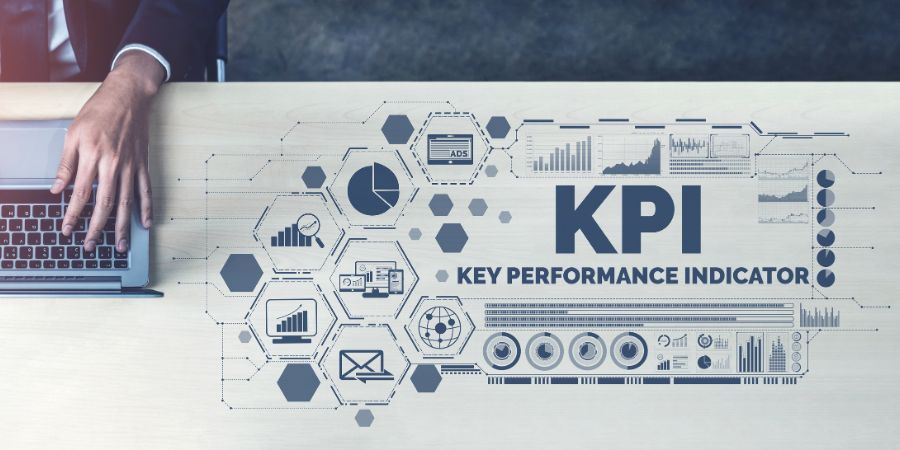Evaluating your company’s performance is critical to ensure its success and growth. But how do you assess performance? Enter the Key Performance Indicators or KPIs. These valuable metrics provide valuable insights into various aspects of your company’s financial health, allowing you to make informed decisions and drive positive change.
The experts at Protea Financial can assist you with everything from analyzing financial statements to understanding key ratios such as gross profit margin, net profit margin, debt-to-equity ratios, and inventory turnover. We’ll show you how our experience can help you effectively assess your company’s performance. Let’s start and discover a new way to measure your success!
What KPIs (Key Performance Indicators) Mean for Small Businesses
Key Performance Indicators, or KPIs, serve as a guidepost for small businesses. They provide valuable insights and measurements of various aspects of your company’s performance, assisting you in staying on track to meet your objectives. These indicators are more than just financial metrics; they include many factors contributing to your company’s overall success and growth.
By focusing on specific KPIs that are relevant to your industry and objectives, you can gain clarity on which areas require improvement and where opportunities exist. Monitoring customer satisfaction rates, for example, can highlight areas that require improved service or product enhancements. Tracking employee productivity can reveal operational inefficiencies as well as opportunities for training and development.
The beauty of KPIs is their ability to be tailored to each business’s specific needs. There is a KPI out there that can help you assess the health and progress of your small business, whether it’s measuring sales revenue growth, website traffic conversion rates, or customer retention rates.
Using KPI tracking systems, you can identify trends over time. By monitoring these indicators regularly, you can identify patterns that indicate positive growth or potential risks before they become major issues. Instead of relying solely on instinct or guesswork, this proactive approach allows quick adjustments and strategic decision-making based on real-time data.
Using KPIs gives small businesses the knowledge they need to make informed decisions for long-term growth. It assists in identifying strengths to leverage further while addressing weaknesses as soon as possible. Success becomes more tangible than ever with the right indicators guiding your path forward!
Financial Statement Analysis
Financial statement analysis is an important part of evaluating a company’s performance. You can gain valuable insights into various aspects of your company’s operations and identify areas for improvement by carefully examining the financial statements.
- The Gross Profit Margin is an important metric to consider because it measures how efficiently a company generates profit from its revenue. It indicates whether production costs are effectively managed and whether pricing strategies are appropriate.
- Another important metric is the Net Profit Margin, which shows how much profit a company makes after deducting all expenses, including taxes and interest. This metric demonstrates your company’s overall profitability and can assist you in determining its financial health.
- Debt-to-equity ratios are also important in determining a company’s financial situation. This ratio compares a company’s total debt to shareholder equity, indicating how much leverage it has taken on in relation to its assets. A high ratio could indicate overborrowing or financial insecurity.
- Furthermore, analyzing Inventory Turnover allows businesses to determine how quickly they sell their inventory over a period. High turnover rates indicate effective inventory management, whereas low rates may indicate problems such as overstocking or slow sales.
- Comparing previous annual reports can provide valuable historical data for benchmarking. You can identify patterns in performance by reviewing trends over time, which will help you make informed decisions about future strategies and goals.
Small businesses can accurately evaluate their performance by conducting thorough Financial Statement Analysis with relevant KPIs. It provides critical information about various aspects of your business, including:
- Profitability
- Cost and resource management efficiency
- Debt level stability
- Inventory management effectiveness
- Historical trends that inform decision-making processes
- And more
Protea Financial Services specializes in assisting businesses in assessing their financial performance through comprehensive analysis tailored to each client’s needs.
Gross Profit Margin: Understanding Your Business’s Financial Health
The gross profit margin is an important metric for small businesses to monitor. This key performance indicator (KPI) assesses the profitability of your core business operations by calculating the percentage of revenue remaining after deducting direct costs.
A high gross profit margin indicates that your company is making a healthy profit from its core operations. A low margin, on the other hand, may indicate inefficiencies or pricing issues.
The calculation of your gross profit margin is simple. Deduct the cost of goods sold (COGS) from the total revenue and divide the result by the total revenue. The resulting percentage represents the amount of money left over after covering operating expenses and generating net profit.
Monitoring this KPI over time allows you to spot trends and make educated decisions about pricing strategies, production costs, and operational efficiency improvements. It can also assist you in benchmarking against industry standards or competitors’ performance.
Understanding your gross profit margin allows you to assess your company’s financial health and make data-driven decisions for growth and sustainability. Small businesses can position themselves for long-term success in their respective industries by closely monitoring this KPI.

Net Profit Margin
Net Profit Margin is a critical financial ratio that provides valuable insights into your company’s profitability. It calculates the percentage of revenue that remains as profit after all expenses are deducted. In layman’s terms, it tells you how effectively your company generates profits.
A high net profit margin indicates that your company effectively manages costs and generates healthy profits. A low net profit margin, on the other hand, may indicate problems with pricing strategies or excessive expenses.
To calculate the net profit margin, divide your net income by your total revenue and multiply by 100. For example, if your net income is $50,000 and your total revenue is $500,000, your net profit margin is 10%.
Monitoring changes in this ratio over time can help you identify trends and make informed pricing or expense control decisions. A net profit margin that is consistently increasing reflects strong financial performance and efficient operations.
Protea Financial recognizes the importance of examining the Net Profit Margin for small businesses. They provide valuable guidance on improving profitability and optimizing business performance by working closely with their clients to assess this metric within their industry context accurately.
Remember that Net Profit Margin should not be viewed in isolation but in conjunction with other KPIs to understand your company’s financial health comprehensively.
Debt to Equity Ratios
When evaluating the financial performance of your small business, one important metric to consider is the debt-to-equity ratio. This ratio determines how much your company’s funding comes from debt versus equity.
A high debt-to-equity ratio indicates that your company relies heavily on borrowed funds, which could be cause for concern. A lower ratio, on the other hand, indicates that your company has a more solid financial foundation and is less reliant on outside funding.
Analyzing this ratio lets you learn how well your company manages its finances and whether it is taking on too much debt. It also assists lenders in determining the risk of lending you money.
Divide total liabilities by shareholders’ equity to calculate the debt-to-equity ratio. The resulting figure will give you a clear picture of your company’s financial structure and ability to meet its obligations.
Monitoring changes in this ratio over time can help you identify trends and make informed decisions about debt management or capital raising. Maintaining a healthy balance of debt and equity is critical for long-term success. At Protea Financial, we recognize the significance of key financial ratios, such as the debt-to-equity ratio, in assessing overall business performance. Our team of experts can help you navigate this process and make data-driven decisions for long-term growth. Call us right away!

Inventory Turnover
Inventory turnover is an important financial metric that can provide valuable insights into your company’s efficiency. It measures how quickly your company’s inventory is sold and replaced with new stock. In other words, it indicates how effectively you manage your inventory levels.
A high inventory turnover ratio indicates that your company sells products quickly and efficiently. This indicates high demand for your products and effective stock management. A low inventory turnover ratio, on the other hand, may indicate issues such as overstocking or slow sales.
Divide the cost of goods sold (COGS) by the average value of inventory over a given time period to calculate inventory turnover. The outcome represents how many times you sold and replaced your entire stock during that time period.
You can identify trends in consumer demand, evaluate product performance, and make informed decisions about purchasing and production strategies by analyzing this KPI. A high turnover rate may prompt you to adjust ordering quantities or diversify product offerings to meet your customers’ needs better.
Monitoring changes in inventory turnover over time allows you to identify potential problems early on before they significantly impact profitability. Reviewing this metric regularly allows you to fine-tune operations and optimize cash flow by managing stock levels more effectively.
Understanding your company’s position in relation to industry benchmarks is also critical when accurately assessing inventory turnover ratios. When you compare yourself to competitors or industry standards, you can identify areas for improvement or potential advantages.
Tracking the Inventory Turnover KPI provides valuable information about how well your company manages its inventories, ensuring efficient resource use while effectively meeting customer demands!
Compare Past Annual Reports
When evaluating your small business’s performance, comparing previous annual reports is a useful tool. These reports provide a thorough overview of your company’s financial health and can reveal trends and patterns that may have an impact on future performance.
By carefully analyzing previous annual reports, you can gain insight into key financial indicators such as revenue growth, profit margins, and cash flow. This data is critical for making informed decisions about the direction of your company.
Revenue growth is an important factor to consider when comparing previous annual reports. By comparing revenue year over year, you can determine whether your company is growing steadily or if any fluctuations need to be addressed.
Profit margins are another important factor to consider. Comparing gross profit margin and net profit margin over time can assist you in identifying areas where costs may be eroding profitability or where pricing strategies are producing positive results.
Debt-to-equity ratios can also provide insight into your company’s overall financial stability. A high debt-to-equity ratio could indicate a lack of liquidity or an overreliance on borrowing.
Inventory turnover rates are important to consider. When you compare how quickly inventory moves off the shelves from one year to the next, you can understand how efficiently you manage inventory levels and sales volumes.
Comparing previous annual reports allows you to track your small business’s progress over time and identify areas for improvement or additional investment. It’s a must-do to stay ahead in today’s competitive market.
Protea Financial Can Help You Assess Your Business Performance
Assessing your company’s performance is critical to its long-term success. You can make informed decisions to drive growth and profitability by understanding key financial indicators and analyzing past performance.
Protea Financial specializes in assisting small businesses in evaluating their financial performance. Our experts will collaborate with you to analyze your financial statements, calculate key performance indicators (KPIs), and provide valuable insights into the overall health of your business.
You can gain a clear understanding of your gross profit margin, net profit margin, debt to equity ratios, and inventory turnover with our assistance. These metrics will assist you in identifying areas for improvement and optimizing your operations for maximum efficiency.
The Role of Real-Time Data in Evaluating Business Performance
In today’s fast-paced business environment, waiting for quarterly or annual reports to assess performance can lead to missed opportunities. Real-time data provides an immediate, up-to-date snapshot of a company’s operations, allowing for timely adjustments and proactive decision-making.
Real-time data enables small businesses to track Key Performance Indicators (KPIs) such as sales, cash flow, and inventory levels on a daily or even hourly basis. This immediate access to data can be especially useful for identifying and responding to trends as they emerge, rather than retroactively analyzing data that may be outdated by the time it’s reviewed. For example, if a retailer sees a sudden spike in inventory turnover for a particular item, they can respond quickly by restocking to meet demand and prevent stockouts.
Additionally, real-time data allows for continuous improvement in customer service and satisfaction. By monitoring metrics like response times, order fulfillment rates, and customer feedback in real time, businesses can make adjustments that enhance the customer experience immediately. Similarly, employee productivity and operational efficiency can be tracked and optimized as needed, rather than at the end of a performance cycle.
Using real-time data to monitor KPIs enhances agility and responsiveness, both of which are crucial for small businesses aiming for long-term growth.

Frequently Asked Questions
1. What are Key Performance Indicators (KPIs) and Why Are They Important for Small Businesses?
KPIs are essential metrics that help you monitor your business’s performance and stay aligned with your goals. They provide insights that guide decision-making and drive growth.
2. How Can Financial Statement Analysis Improve My Business’s Performance?
Financial statement analysis reveals the strengths and weaknesses in your finances, helping you make informed decisions. It’s crucial for identifying areas where you can optimize costs and boost profitability.
3. Why is Gross Profit Margin Crucial for Small Business Owners?
Gross profit margin shows how efficiently you’re generating profit from sales. It’s key to understanding your pricing and cost management strategies.
4. How Can I Use Net Profit Margin to Gauge My Business’s Success?
Net profit margin indicates the percentage of revenue left after all expenses, reflecting your overall profitability. Monitoring it helps ensure your business is on a healthy financial path.
5. What Does a High Debt-to-Equity Ratio Mean for My Business?
A high debt-to-equity ratio suggests heavy reliance on borrowed funds, which can be risky. Keeping this ratio balanced is vital for financial stability.
6. How Can Inventory Turnover Affect My Business’s Cash Flow?
High inventory turnover indicates efficient sales and strong cash flow. Low turnover may signal issues like overstocking, impacting your liquidity.
7. Why Should Small Businesses Compare Past Annual Reports?
Comparing past annual reports helps you track financial progress and identify trends. This analysis is essential for making informed future decisions.
8. How Can I Improve My Gross Profit Margin?
To improve your gross profit margin, focus on reducing costs or adjusting your pricing strategy. These steps will help increase profitability.
9. What Role Does Net Profit Margin Play in Business Planning?
Net profit margin is crucial for evaluating your business’s true profitability and planning for growth. It helps you determine if your strategies are financially sustainable.
10. How Can I Maintain a Healthy Debt-to-Equity Ratio?
Maintain a healthy debt-to-equity ratio by balancing borrowed funds with your own capital. This ensures long-term financial health and investor confidence.



